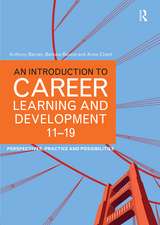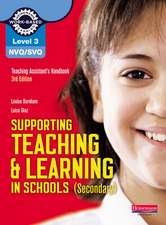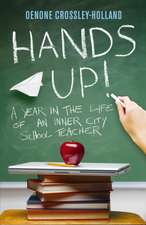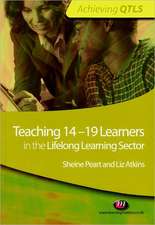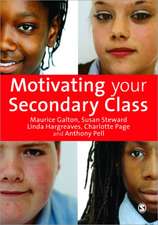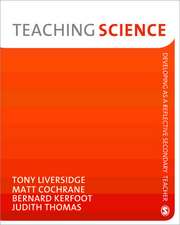Unleashing the Potential of the Teenage Brain: Ten Powerful Ideas
Autor Barry Doran Corbinen Limba Engleză Paperback – 11 noi 2007
- descriptions of the changing and differing roles and expectations for both teachers and students in the brain-compatible classroom
- extensive explanations of the kind of learning environment we need to establish and how teachers ought to go about establishing this desired learning environment.
This is an ideal resource for teachers, teacher educators, and parents of teenagers.
| Toate formatele și edițiile | Preț | Express |
|---|---|---|
| Paperback (1) | 260.51 lei 6-8 săpt. | |
| SAGE Publications – 11 noi 2007 | 260.51 lei 6-8 săpt. | |
| Hardback (1) | 499.44 lei 6-8 săpt. | |
| SAGE Publications – 11 noi 2007 | 499.44 lei 6-8 săpt. |
Preț: 260.51 lei
Nou
49.85€ • 54.32$ • 42.00£
Carte tipărită la comandă
Livrare economică 23 aprilie-07 mai
Specificații
ISBN-10: 1412942497
Pagini: 168
Dimensiuni: 216 x 279 x 11 mm
Greutate: 0.51 kg
Ediția:1
Editura: SAGE Publications
Colecția Corwin
Locul publicării:Thousand Oaks, United States
Recenzii
“The information is practical, and the examples make the material very easy to apply. The tone of the book is perfect for educators of middle and high school students—there’s just the right amount of humor about the idiosyncrasies of this age group, as well as an appreciation for the rewards of teaching and working with adolescents.”
"Provides an excellent overview of the current research and knowledge on brain functioning."
"A thought-provoking resource firmly grounded in research and best practice, this handbook of exemplary ideas for teaching the teenage brain is organized in a brain-friendly format and includes a wealth of brain-friendly instructional strategies, from engaging activators to rich opportunities for reflection. A must-read for all educators and an excellent resource for faculty study groups and book clubs."
"Any teaching library needs this."
Cuprins
About the Author
Part I. Discovering the Teenage Brain
1. Introduction: The Creatures in the Classroom! Those Exasperating and Unfathomable Teenagers
How Do We Reach and Teach Those Unpredictable Teenage Brains?
Wanted: A New Approach to Teaching Teenagers!
Why Educators Need to Learn About the Teenage Brain
Brain-Compatible Teaching and the New Science of Learning
The Emergence of a New Pedagogical Model
2. Adolescence and the Teenage Brain--What Is Different and How Do We Know?
Adolescence--Just the Quick Facts!
The Teenage Brain--What We Had Believed
How Neuroscience and Medical Technology Are Changing Our Ideas About the Teenage Brain
The Future of Brain Imaging
3. Big Changes in the Teenage Brain: What We Have Learned and Are Learning
The Teenage Brain--A Work in Progress
From Back to Front: Brain Growth, Neuron Proliferation and Pruning, Myelin Development
What It All Means (We Think!)
Looking Back at Part I : Reflection and Review
Part II. Ten Powerful Ideas About the Brain and Learning and What It Means for Teaching the Teenage Brain
4. Powerful Idea #1: Constructing New Knowledge
What Powerful Idea #1 Means for Teachers: Helping Teenagers Construct Personal Meaning
How It Might Look--A Case Study: "Saving the Old Victoria Street School"
Constructivist Teaching Strategies
5. Powerful Idea #2: Different Ways of Learning
Being Smart-- Human Intelligence
Preferred Ways of Learning--Our Learning Styles
What Powerful Idea #2 Means for Teachers: Teaching to Each Unique Brain
Unleashing the Potential of the Teenage Brain: Six Things You Ought to Do
How It Might Look--A Case Study: "Ms. Taylor's Meteorology Unit"
6. Powerful Idea #3: Making Meaning, Connections, and Patterns
What Powerful Idea #3 Means for Teachers: Developing Pattern Making and Detecting Abilities
Some Strategies for You to Consider
How It Might Look--A Case Study: "Mrs. Parasiuk's Poetry Class"
7. Powerful Idea #4: Whole-Brain Learning
Left, Right, or Both Brains?
What Powerful Idea #4 Means for Teachers: Effective Ways to Make Your Classroom Teaching Whole Brain
How It Might Look--A Case Study: "Whole-Brain Assessment in Mr. Amos' Horticulture Class"
8. Powerful Idea #5: Multiple Memory Pathways
Different Kinds of Memory--Declarative Versus Procedural
Learning and Memory
What Powerful Idea #5 Means for Teachers: Using Multiple Memory Pathways
How It Might Look--A Case Study: "Mrs. Singh's Musical Science"
9. Powerful Idea #6: Physical Activity and Movement
Exercise For the Brain
What Powerful Idea #6 Means for Teachers: Utilizing Physical Activity to Enhance Learning
How It Might Look--A Case Study: "Kinesthetic Learning in High School Biology"
10. Powerful Idea #7: Memory, Learning, and Emotion
Too Much or Too Little?
The Impact of High Stress and Threat
Brain Attention and Focus
Motivation and Engagement
What Powerful Idea #7 Means for Teachers: Managing the Emotional Environment of the Classroom
How It Might Look--A Case Study: "The Affirmative Mr. Hawkes"
11. Powerful Idea #8: Reflection and Self-Assessment
Knowing Oneself
Reflection
Metacognition
What Powerful Idea #8 Means for Teachers: Developing Reflective Learners
How It Might Look--A Case Study: "Feedback and Reflection in the Visual Arts Class"
12. Powerful Idea #9: Social Interaction and Learning
What Powerful Idea #9 Means for Teachers: Providing for Social Interaction and Collaboration
How It Might Look--A Case Study: "A Jigsaw Activity in High School Political History"
13. Powerful Idea #10: Time and Timing
When Is the Best Time?
An Optimal Time to Learn
An Optimal Time Pattern for Learning
The Optimal Times During the Learning Episode
The Optimal Times During the Day
What Powerful Idea #10 Means for Teachers: Taking Advantage of Time and Timing
How It Might Look--A Case Study: "Mrs. Gregory's Lesson Planning"
Looking Back at Part II - Reflection and Review
Part III. The Classroom Environment and What Teachers and Students Should Be Doing
14. The Learning Environment
The Physical Environment
The Socioemotional Environment
The Intellectual Environment
15. The Brain-Compatible Teacher: Changing and Evolving Roles
A Complex and Challenging Profession!
The Teacher as Facilitator, Orchestrator, and Conductor
The Teacher as Coach and Model
The Teacher as Continuous Learner
The Teacher as Monitor, Assessor, and Evaluator
The Teacher as a Resource
16. Teenage Students: Higher Expectations and New Roles
What We Want and Need From Our Teenage Students
Looking Back at Part III - Reflection and Review
Part IV. Now What? So What?-- Reflecting Upon What We Have Learned
17. What Does It All Mean?
A Quick Review: The Important Things We Have Learned
What Do We Need to Do to Help Teenagers Reach Their Potential?
Some Final Thoughts: Opening Doorways to Possibilities
Wanted: An Epidemic for an Idea
Glossary
Suggested Readings
Bibliography
Index
Notă biografică
Barry Corbin, M.Ed., is an educational consultant and part-time lecturer in the School of Education, Acadia University, Nova Scotia, Canada. He is recently retired from the Annapolis Valley Regional School Board, where he served for over 30 years as teacher, school administrator, curriculum and program consultant and staff developer. Barry has also served as consultant and advisor to several Department of Education initiatives for the province of Nova Scotia, Canada. In his last role with the AVRSB, he served as Youth Pathways and Transitions consultant where he was responsible for researching and developing alternate educational programs and pathways for under-achieving high school students. As an independent consultant, he frequently presents at professional development workshops and in-services on such topics as brain-compatible teaching and learning, multiple intelligences and learning styles, differentiated instruction, authentic assessment as well as collaborative/cooperative teaching strategies. His workshops are enthusiastically endorsed by those in attendance because he engages his audiences with many of the interactive strategies he advocates in his writing.
Barry holds a Bachelor of Science degree (geology) from Acadia University, a Bachelor of Education from the same institution and a Master of Education in Curriculum Development from St. Mary¿s University in Halifax, Nova Scotia. He is the co-author of two high school social studies texts used in Atlantic Canada.


